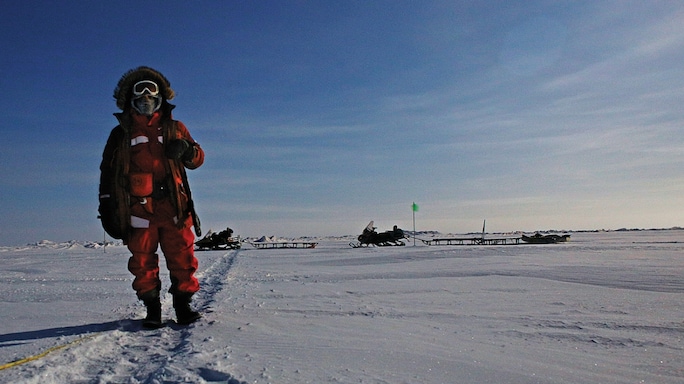- HOME
- /
- True Stories
- /
- My Story
- /
The Long Winter Night
A scientist describes the brutal and awe-inspiring wonders of living and working on the frozen Polar oceans
 A moon-lit night during the the MOSAiC Expedition. In the background are skidoos (snow scooters) that help transport people and equipment across the sea ice.Photo credit Matthias Jaggi
A moon-lit night during the the MOSAiC Expedition. In the background are skidoos (snow scooters) that help transport people and equipment across the sea ice.Photo credit Matthias Jaggi
Imagine a warm, summer day at Juhu Beach in Mumbai. Ocean waves crash along the shore; a balmy wind brings sea spray upon your face; the sun glimmers on the horizon. But what if the sun sets in Juhu and doesn’t rise again for months? It’s pitch dark all hours of the day and the sea freezes over? And you can walk, run or even drive your car across the frozen beach floating on top of an ocean. Sound surreal? Well, this is the kind of place where I’ve spent long stints of my professional life over the last decade or so. As a sea ice remote sensing scientist, I overwinter in the 24x7 polar darkness and frigid temperatures of six-month-long nights in the Arctic and the Antarctic.
Living and working in the one of the most extreme and remote parts of the world was a happy accident. Like many middle-class Indians my age, I trained to be an electronics engineer and, after graduation, was placed in an IT company. It was dreary work and before long, I resigned. After a year-long struggle attempting to crack various PSU exams with no success, I ended up pursuing a Master’s in Earth Observation Sciences from the International Institute for Geo-Information Science and Earth Observation (ITC) in the Netherlands, in collaboration with the Indian Institute of Remote Sensing, ISRO. That changed my life. I finished my degree in 18 months, and moved to the Alfred Wegener Institute for Polar and Marine Research in Germany as a research associate and started working on the Antarctic ice cap. A PhD in Geography from the University of Calgary, Canada, three more post-doctoral fellowships and 15 field seasons at the north and south Poles later, I am proud to be an experienced research scientist.
 German icebreaker and research vessel, the R/V Polarstern near the North Pole. Although it looks stable, the anchored ship is moving along with the drifting ice. photo credit Steffen Graupner
German icebreaker and research vessel, the R/V Polarstern near the North Pole. Although it looks stable, the anchored ship is moving along with the drifting ice. photo credit Steffen Graupner
Part of my job entails using radar satellite data to monitor polar sea ice decline to study global climate change. From 2019 to 2020, I was part of the MOSAiC International Arctic Drift Expedition—the largest and longest expedition in polar history. I was also the only Indian who participated in this year-long campaign. As part of our regular work, my team and I go on field expeditions to deploy radar sensors on sea ice that scan the surface, similar to a radar satellite. This allows us to compare satellite data with ground measurements to make sure the former are correct.
It’s definitely not your average day at the office. Snow that falls on sea ice turns salty, affecting the accuracy of our measurements. Temperatures often plummet to below –50°C, exacerbating the toll of a 10-hour shift. Even with cold protection gear, I suffered temporary frost nips and permanent frostbite on my fingers.
Wind gusts at 100 kph push temperatures down by another 10 degrees and can easily break apart the ice, opening up cracks and exposing the ocean. A few times, we lost instruments that fell through into the water; luckily none of the crew has. And if one of us did slip in, float suits keep us safe. But we are always careful. We have to be, because an emergency medical evacuation could take anywhere between 10 days to 14 days. The nearest hospital may be many thousand kilometres, or even a continent away.
 MOSAiC crew members, including the author, work on a sensor system on the sea ice. Each sensor is around five metres tall and weighs about 300 kg once assembled. Photo: Lars Barthel
MOSAiC crew members, including the author, work on a sensor system on the sea ice. Each sensor is around five metres tall and weighs about 300 kg once assembled. Photo: Lars Barthel
Besides being unable to clearly mark the passage of time, the lack of sunlight extracts both a physical and a mental toll. One’s internal clock turns off, leading to constant fatigue and little motivation for focussed work. My mood swings like a very low amplitude sine wave. Missing family and friends add to the sore.
In stark contrast to where I grew up—in warm, lush green Trivandrum, Kerala, filled with rich sights, sounds and people—life at the Poles is quiet. The harshness of winter brings along with it an eerie desolation and near-total silence. Survival in this frigid, dark and windy terrain is only for the fittest. A misstep can mean anything from an icy injury to a bitter, benumbed death. But while it is tenuous, life here is also humbling—physically, mentally, even spiritually. The experience has allowed me to witness the wonderous dualities of nature: raw, brutal and unforgiving, but nurturing and awe-inspiring at the same time.
As the days shorten, almost all life starts to depart seeking warmer lands. But those who stay are surrounded by glacial beauty and an otherworldly stillness that stands unmatched. In peak winter months, the sun seems to live only in memory. Its absence however, is only an illusion: Shimmering displays of blue, red, yellow, green and orange auroras shifting and snaking like billowing curtains across the pitch black sky remind me that the light shall one day return.
Even the emptiness of the land is deceptive. Look closely and out waddles a flock of penguins from behind an ice shelf on the Antarctic peninsula. A bit of patience and you’ll spy an Arctic seal poking its head curiously through the ice. And then there are of course the far less subtle visits from polar bears, who enjoy knocking over our equipment and chewing up cables. The desert teems with amusing company for us out-of-place humans.
It took me years to adapt and fall in love with these environments and now I am excited to embed myself in yet another stint in this land of darkness and slow-moving time. What pulls me back time and again, is its unyielding tranquillity. It tames you, fills you with wonder and changes your soul. Inherently restless by nature, I have had to find patience, resolve, and learn how to solve problems without losing control.
Success on a Polar campaign is only possible through kindness and collaboration. There is no room for selfish science. Colleagues who were once impersonal cogs in a giant machine turn into fast friends who help one navigate the heavy tolls of the day. I have always been lucky to be able to find pals on these campaigns who help keep me afloat. One of my best friends, Dr Rasmus Tonboe, an Associate Professor at the Technical University of Denmark, is one such partner-in-arms. Rasmus and I met on MOSAiC and soon began a nightly ritual of sitting together to vent our frustrations or share a laugh. One night, we even shaved each other’s hair to commemorate the full moon!
 The author (in green) during New Year celebrations in 2020. With him (left to right) are his MOSAiC colleagues Marcus, Huntemann, Rasmus Tonboe and Julienne Stroeve. Photo Credit: Arttu Jutila
The author (in green) during New Year celebrations in 2020. With him (left to right) are his MOSAiC colleagues Marcus, Huntemann, Rasmus Tonboe and Julienne Stroeve. Photo Credit: Arttu Jutila
When the captain of the German icebreaker ship R/V Polarstern learnt that I love cooking, he and the chef aboard allowed me to prepare Indian meals a few times for the scientists and crew. Imagine tandoori chicken, tofu butter masala (no paneer on board) and vegetable pulao at the North Pole! Such small joys and support are just the things that can help you forget that you’re so far from home.From March 2023, I will overwinter for nine months at the British Antarctic Survey’s Rothera station. It’s not a life meant for everyone, but sharing my experiences with others has brought great satisfaction. I conduct outreach sessions about my time in the Poles with school children, undergraduate students and early-career researchers in India and abroad.
Community engagement with people living in Arctic communities has also offered valuable insight and information on how the environment has changed over the years. The stories we exchange reinforce how important it is for us to reach out to our neighbours, to dispense knowledge and inspire others to think differently about the beauty, power and fragility of our planet, whose fate rests in our hands.






